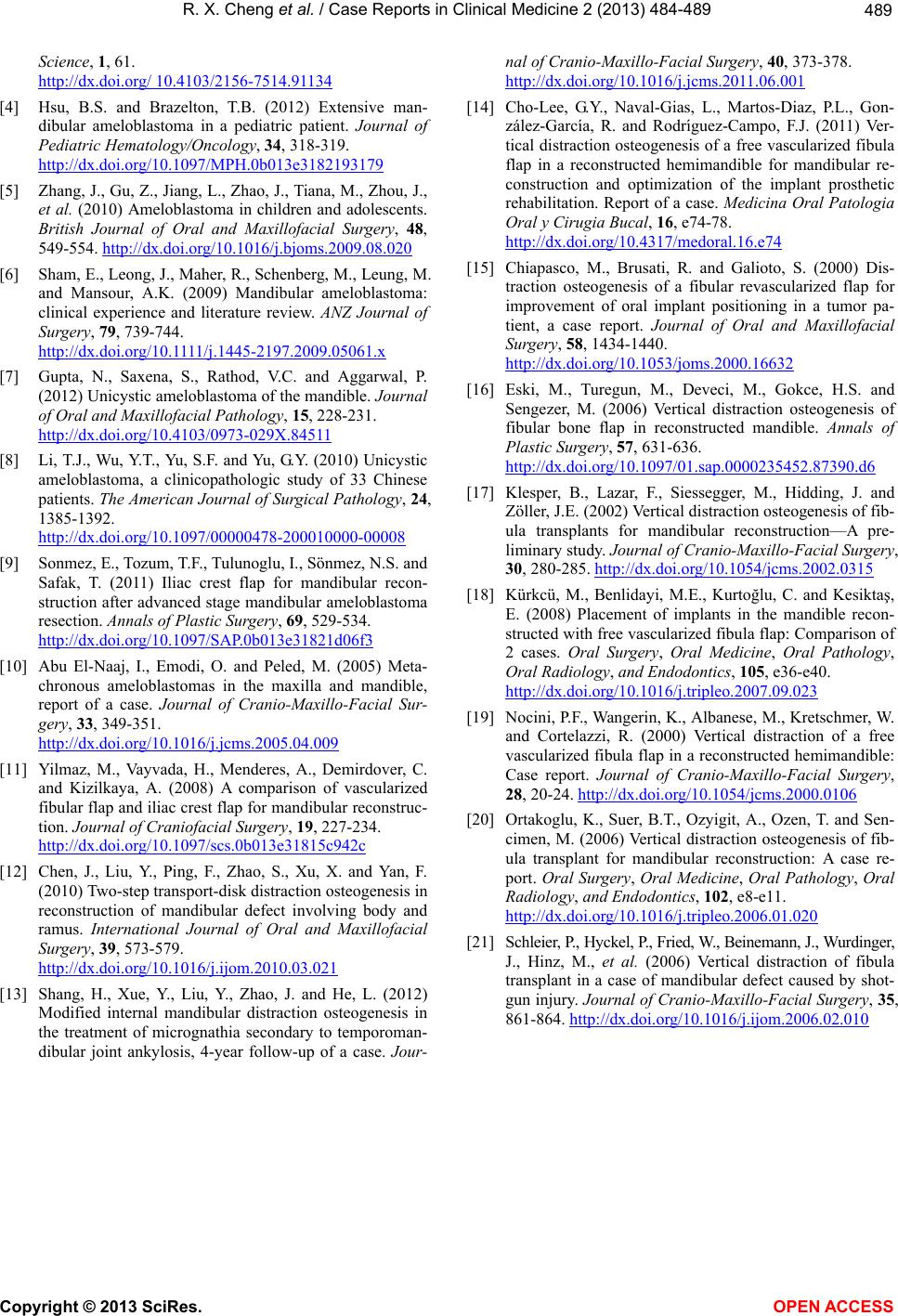
R. X. Cheng et al. / Case Reports in Clinical Medicine 2 (2013) 484-489
Copyright © 2013 SciRes. OPEN ACCESS
489
Science, 1, 61.
http://dx.doi.org/ 10.4103/2156-7514.91134
[4] Hsu, B.S. and Brazelton, T.B. (2012) Extensive man-
dibular ameloblastoma in a pediatric patient. Journal of
Pediatric Hematology/Oncology, 34, 318-319.
http://dx.doi.org/10.1097/MPH.0b013e3182193179
[5] Zhang, J., Gu, Z., Jiang, L., Zhao, J., Tiana, M., Zhou, J.,
et al. (2010) Ameloblastoma in children and adolescents.
British Journal of Oral and Maxillofacial Surgery, 48,
549-554. http://dx.doi.org/10.1016/j.bjoms.2009.08.020
[6] Sham, E., Leong, J., Maher, R., Schenberg, M., Leung, M.
and Mansour, A.K. (2009) Mandibular ameloblastoma:
clinical experience and literature review. ANZ Journal of
Surgery, 79, 739-744.
http://dx.doi.org/10.1111/j.1445-2197.2009.05061.x
[7] Gupta, N., Saxena, S., Rathod, V.C. and Aggarwal, P.
(2012) Unicystic ameloblastoma of the mandible. Journal
of Oral and Maxillofacial Pathology, 15, 228-231.
http://dx.doi.org/10.4103/0973-029X.84511
[8] Li, T.J., Wu, Y.T., Yu, S.F. and Yu, G.Y. (2010) Unicystic
ameloblastoma, a clinicopathologic study of 33 Chinese
patients. The American Journal of Surgical Pathology, 24,
1385-1392.
http://dx.doi.org/10.1097/00000478-200010000-00008
[9] Sonmez, E., Tozum, T.F., Tulunoglu, I., Sönmez, N.S. and
Safak, T. (2011) Iliac crest flap for mandibular recon-
struction after advanced stage mandibular ameloblastoma
resection. Annals of Plastic Surgery, 69, 529-534.
http://dx.doi.org/10.1097/SAP.0b013e31821d06f3
[10] Abu El-Naaj, I., Emodi, O. and Peled, M. (2005) Meta-
chronous ameloblastomas in the maxilla and mandible,
report of a case. Journal of Cranio-Maxillo-Facial Sur-
gery, 33, 349-351.
http://dx.doi.org/10.1016/j.jcms.2005.04.009
[11] Yilmaz, M., Vayvada, H., Menderes, A., Demirdover, C.
and Kizilkaya, A. (2008) A comparison of vascularized
fibular flap and iliac crest flap for mandibular reconstruc-
tion. Journal of Craniofacial Surgery , 19, 227-234.
http://dx.doi.org/10.1097/scs.0b013e31815c942c
[12] Chen, J., Liu, Y., Ping, F., Zhao, S., Xu, X. and Yan, F.
(2010) Two-step transport-disk distraction osteogenesis in
reconstruction of mandibular defect involving body and
ramus. International Journal of Oral and Maxillofacial
Surgery, 39, 573-579.
http://dx.doi.org/10.1016/j.ijom.2010.03.021
[13] Shang, H., Xue, Y., Liu, Y., Zhao, J. and He, L. (2012)
Modified internal mandibular distraction osteogenesis in
the treatment of micrognathia secondary to temporoman-
dibular joint ankylosis, 4-year follow-up of a case. Jour-
nal of Cranio-Maxillo-Facial Surgery, 40, 373-378.
http://dx.doi.org/10.1016/j.jcms.2011.06.001
[14] Cho-Lee, G.Y., Naval-Gias, L., Martos-Diaz, P.L., Gon-
zález-García, R. and Rodríguez-Campo, F.J. (2011) Ver-
tical distraction osteogenesis of a free vascularized fibula
flap in a reconstructed hemimandible for mandibular re-
construction and optimization of the implant prosthetic
rehabilitation. Report of a case. Medicina Oral Patologia
Oral y Cirugia Bucal, 16, e74-78.
http://dx.doi.org/10.4317/medoral.16.e74
[15] Chiapasco, M., Brusati, R. and Galioto, S. (2000) Dis-
traction osteogenesis of a fibular revascularized flap for
improvement of oral implant positioning in a tumor pa-
tient, a case report. Journal of Oral and Maxillofacial
Surgery, 58, 1434-1440.
http://dx.doi.org/10.1053/joms.2000.16632
[16] Eski, M., Turegun, M., Deveci, M., Gokce, H.S. and
Sengezer, M. (2006) Vertical distraction osteogenesis of
fibular bone flap in reconstructed mandible. Annals of
Plastic Surgery, 57, 631-636.
http://dx.doi.org/10.1097/01.sap.0000235452.87390.d6
[17] Klesper, B., Lazar, F., Siessegger, M., Hidding, J. and
Zöller, J.E. (2002) Vertical distraction osteogenesis of fib-
ula transplants for mandibular reconstruction—A pre-
liminary study. Journal of Cranio-Maxillo-Facial Surgery,
30, 280-285. http://dx.doi.org/10.1054/jcms.2002.0315
[18] Kürkcü, M., Benlidayi, M.E., Kurtoğlu, C. and Kesiktaş,
E. (2008) Placement of implants in the mandible recon-
structed with free vascularized fibula flap: Comparison of
2 cases. Oral Surgery, Oral Medicine, Oral Pathology,
Oral Radiology, and Endodontics, 105, e36-e40.
http://dx.doi.org/10.1016/j.tripleo.2007.09.023
[19] Nocini, P.F., Wangerin, K., Albanese, M., Kretschmer, W.
and Cortelazzi, R. (2000) Vertical distraction of a free
vascularized fibula flap in a reconstructed hemimandible:
Case report. Journal of Cranio-Maxillo-Facial Surgery,
28, 20-24. http://dx.doi.org/10.1054/jcms.2000.0106
[20] Ortakoglu, K., Suer, B.T., Ozyigit, A., Ozen, T. and Sen-
cimen, M. (2006) Vertical distraction osteogenesis of fib-
ula transplant for mandibular reconstruction: A case re-
port. Oral Surgery, Oral Medicine, Oral Pathology, Oral
Radiology, and Endodontics, 102, e8-e11.
http://dx.doi.org/10.1016/j.tripleo.2006.01.020
[21] Schleier, P., Hyckel, P., Fried, W., Beinemann, J., Wurdinger,
J., Hinz, M., et al. (2006) Vertical distraction of fibula
transplant in a case of mandibular defect caused by shot-
gun injury. Journal of Cranio-Maxillo-Facial Surgery, 35,
861-864. http://dx.doi.org/10.1016/j.ijom.2006.02.010